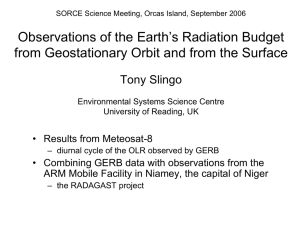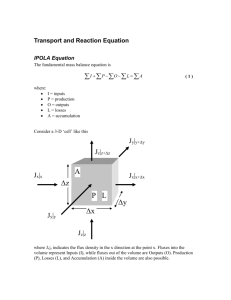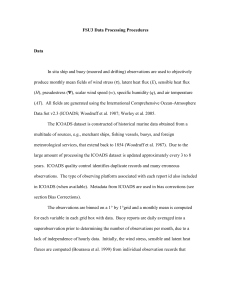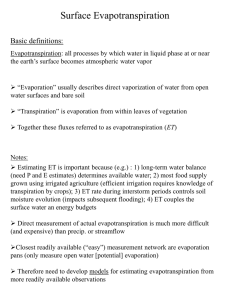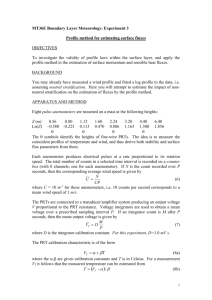Longwave flux determination – proposed changes
advertisement
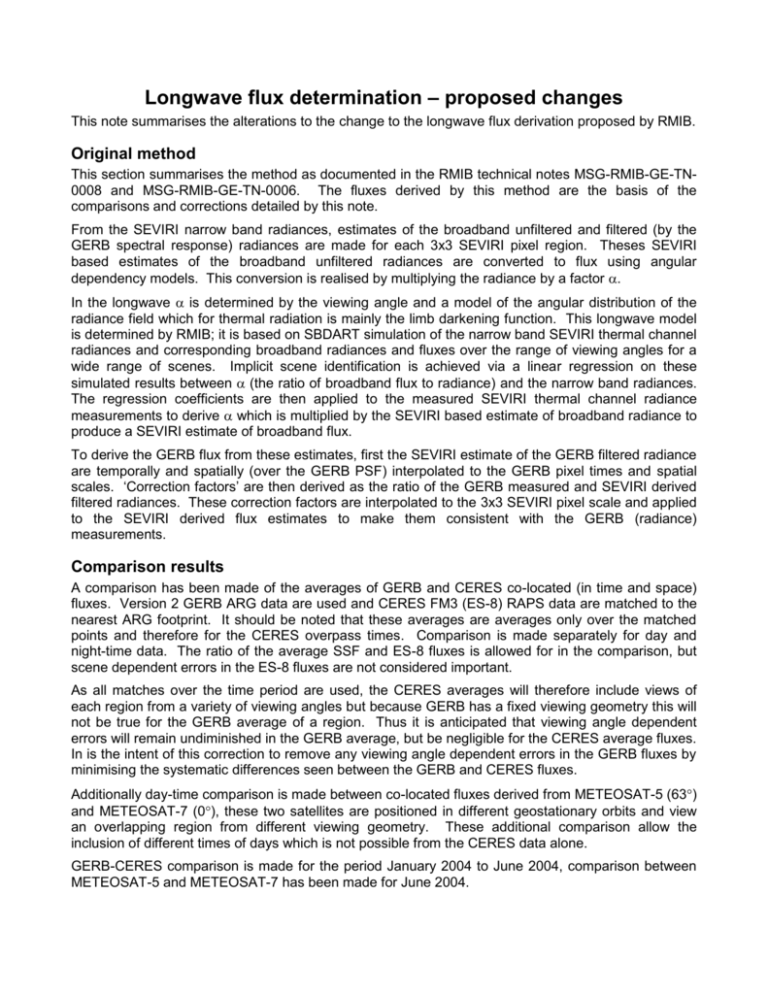
Longwave flux determination – proposed changes This note summarises the alterations to the change to the longwave flux derivation proposed by RMIB. Original method This section summarises the method as documented in the RMIB technical notes MSG-RMIB-GE-TN0008 and MSG-RMIB-GE-TN-0006. The fluxes derived by this method are the basis of the comparisons and corrections detailed by this note. From the SEVIRI narrow band radiances, estimates of the broadband unfiltered and filtered (by the GERB spectral response) radiances are made for each 3x3 SEVIRI pixel region. Theses SEVIRI based estimates of the broadband unfiltered radiances are converted to flux using angular dependency models. This conversion is realised by multiplying the radiance by a factor . In the longwave is determined by the viewing angle and a model of the angular distribution of the radiance field which for thermal radiation is mainly the limb darkening function. This longwave model is determined by RMIB; it is based on SBDART simulation of the narrow band SEVIRI thermal channel radiances and corresponding broadband radiances and fluxes over the range of viewing angles for a wide range of scenes. Implicit scene identification is achieved via a linear regression on these simulated results between (the ratio of broadband flux to radiance) and the narrow band radiances. The regression coefficients are then applied to the measured SEVIRI thermal channel radiance measurements to derive which is multiplied by the SEVIRI based estimate of broadband radiance to produce a SEVIRI estimate of broadband flux. To derive the GERB flux from these estimates, first the SEVIRI estimate of the GERB filtered radiance are temporally and spatially (over the GERB PSF) interpolated to the GERB pixel times and spatial scales. ‘Correction factors’ are then derived as the ratio of the GERB measured and SEVIRI derived filtered radiances. These correction factors are interpolated to the 3x3 SEVIRI pixel scale and applied to the SEVIRI derived flux estimates to make them consistent with the GERB (radiance) measurements. Comparison results A comparison has been made of the averages of GERB and CERES co-located (in time and space) fluxes. Version 2 GERB ARG data are used and CERES FM3 (ES-8) RAPS data are matched to the nearest ARG footprint. It should be noted that these averages are averages only over the matched points and therefore for the CERES overpass times. Comparison is made separately for day and night-time data. The ratio of the average SSF and ES-8 fluxes is allowed for in the comparison, but scene dependent errors in the ES-8 fluxes are not considered important. As all matches over the time period are used, the CERES averages will therefore include views of each region from a variety of viewing angles but because GERB has a fixed viewing geometry this will not be true for the GERB average of a region. Thus it is anticipated that viewing angle dependent errors will remain undiminished in the GERB average, but be negligible for the CERES average fluxes. In is the intent of this correction to remove any viewing angle dependent errors in the GERB fluxes by minimising the systematic differences seen between the GERB and CERES fluxes. Additionally day-time comparison is made between co-located fluxes derived from METEOSAT-5 (63) and METEOSAT-7 (0), these two satellites are positioned in different geostationary orbits and view an overlapping region from different viewing geometry. These additional comparison allow the inclusion of different times of days which is not possible from the CERES data alone. GERB-CERES comparison is made for the period January 2004 to June 2004, comparison between METEOSAT-5 and METEOSAT-7 has been made for June 2004. Figure 1 Results of GERB-CERES flux comparison. Average difference over-matched points shown in left hand panels, with average thermal flux shown in right-hand panels. Derived correction In order to remove the difference between CERES and GERB average fluxes, a fit is made to the matched data as follows: FGERB FCERES aFGERB 52.5 vz bF 52.5 corrected GERB flux FGERB aFGERB GERB 52.5 vz 52.5 Where vz is viewing angle in degrees, FGERB and FCERES are the average uncorrected GERB and CERES fluxes and a and b are parameters to be found by the fit. The correction constrains the general offset between the GERB and CERES fluxes to the form b(FGERB) and allows this to remain, but it subtracts a factor which is the multiplication of the derived coefficient a , the uncorrected GERB flux FGERB and a pre-defined function of the viewing angle 52.5 vz . 52.5 Thus by this formulation a(FGERB) is the nadir error due to the GERB longwave ADM error. At 52.5 no error in the ADM is allowed (scene dependent differences are minimised for this viewing angle) and the difference between the GERB and CERES fluxes b(FGERB) is a gross offset that remains uncorrected by this method. In deriving the correction the uncorrected averaged (in time) GERB and CERES fluxes are binned according to their magnitude and the fit performed. The results for nadir viewing angle are shown below. For the METEOSAT comparison the fit is made to the binned uncorrected flux is of the form: FMET 7 FMET 5 aFMET 7 52.5 vz,MET 7 52.5 bFMET 7 52.5 vz,MET 5 52.5 c FMET 7 In this instance a(FMET-7) is the METEOSAT-7 nadir error and b(FMET-5) is the METEOSAT-5 nadir error. The results of these fits are shown in figure 2 below. Figure 2, results of the comparisons for nadir viewing angles, with difference as a function of uncorrected flux. Results are shown for FM3 verses GERB for night (red and purple) and day (pale and dark green), and the average of the METEOSAT 5 and 7 comparisons (blue and brown). From these results a composite fit is derived as shown in figure 3 below. Figure 3 overall composite correction. After application of this correction the comparison with CERES can be made again, the results, before and after correction for night time and day time data are shown below. Figure 4 GERB-CERES (FM3 ES-8) flux differences , before and after correction for matched nighttime points Figure 5 GERB-CERES (FM3 ES-8) flux differences , before and after corrections for matched daytime points Summary A correction to the GERB longwave fluxes of up to around 20 Wm-2 at night and 35 Wm-2 during the day is proposed. The correction has been derived by comparison of co-located GERB ARG and CERES FM3 ES-8 longwave fluxes over a 6 month period (Jan-June 2004) with additional input for day-time by comparison of METEOSAT-5 and METOSAT-8 derived fluxes for June 2004. The correction assumes a linear form with respect to viewing angle, VZ and uncorrected longwave flux, FGERB, F FGERB 52.5 vz . 52.5 The factor is determined from the composite results of the comparisons. For each comparison a fit is made to the time averaged binned uncorrected fluxes of the form: FGERB FCERES aFGERB 52.5 vz bF GERB 52.5 for the GERB-CERES matched points between January 2004 and June 2004, with the fit performed separately for daytime and night-time points, and FMET 7 FMET 5 aFMET 7 52.5 vz,MET 7 52.5 bFMET 7 52.5 vz,MET 5 52.5 c FMET 7 for the METEOSAT-7 and METEOSAT-5 matched daytime points for June 2004. The correction allows an offset between the GERB and CERES fluxes and between the METEOSAT-7 and METEOSAT-5 fluxes which is proportional to the GERB uncorrected flux to remain uncorrected.
